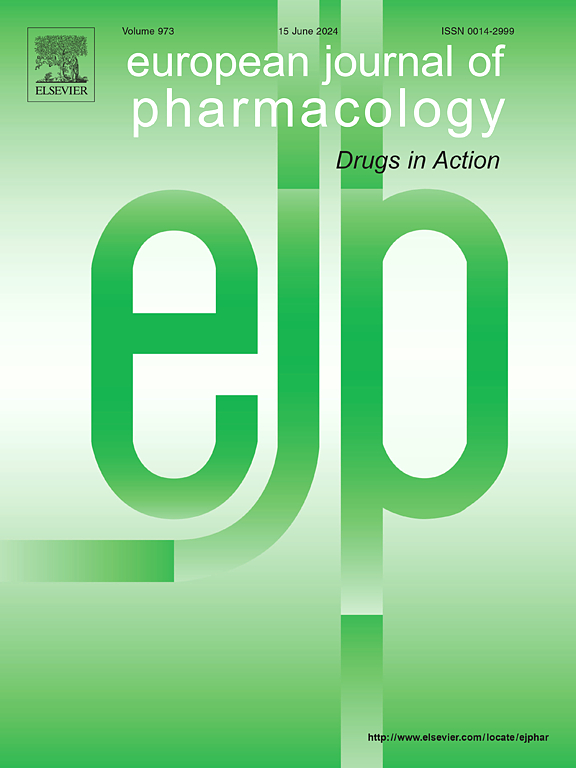Discovery of cinnamoyl–flavonoid hybrid derivatives as inhibitors of SARS-CoV-2 Mpro and anti-inflammatory agents: Experimental and in silico insights into their efficacy against lipopolysaccharide-induced lung injury
IF 4.2
3区 医学
Q1 PHARMACOLOGY & PHARMACY
引用次数: 0
Abstract
The chemical structures of the parental compounds of flavonoids from Boesenbergia rotunda were modified by conjugation with cinnamic acid to form cinnamoyl–flavonoid hybrid derivatives with enhanced anti-inflammatory and SARS-CoV-2 Mpro-inhibitory properties. Cinnamoyl–flavonoid hybrid derivatives 6 and 10 showed the potential to inhibit SARS-CoV-2 Mpro with IC50 values of 52.49 and 22.62 μM. Compounds 6 and 10 showed lower cytotoxicity in the human lung cell lines MRC-5 and A549 at concentrations greater than 50 μM. The effects of compounds 6 and 10 on cell viability were studied in a 3D co-culture model of A549 and MRC-5 treated with lipopolysaccharide (LPS) and observed through confocal microscopy. Compounds 6 and 10 downregulated p65 mRNA expression, resulting in a reduction of pro-inflammatory cytokines, including Interleukin 8 (IL-8) and Monocyte Chemoattractant Protein-1 (MCP-1/CCL2), leading to an anti-inflammatory response through Nuclear factor kappa-light-chain-enhancer of activated B cells (NF-κB) signalling pathways. Compound 6 showed potential anti-inflammatory activity, downregulating Bcl-2 Associated X gene (BAX), which resulted in inhibition of apoptotic cell death when compared to compound 10. In silico molecular dynamic simulation shed light on how these cinnamoyl–flavonoid hybrid derivatives interact with myeloid differentiation factor 2 (MD-2), which is involved in the inflammatory response. Our findings suggest that cinnamoyl–flavonoid hybrid derivatives show potential as anti-inflammatory drugs and anti-SARS-CoV-2 drugs.

肉桂酰类黄酮杂化衍生物作为SARS-CoV-2 Mpro抑制剂和抗炎药的发现:实验和计算机观察其对脂多糖诱导的肺损伤的疗效
通过与肉桂酸偶联的方法,对黄酮类化合物亲本化合物的化学结构进行了修饰,得到了具有抗炎和抑制SARS-CoV-2 mpro活性的肉桂酰黄酮类化合物杂化衍生物。肉桂酰类黄酮杂化衍生物6和10对SARS-CoV-2 Mpro具有抑制作用,IC50值分别为52.49和22.62 μM。化合物6和10在浓度大于50 μM时对人肺细胞系MRC-5和A549具有较低的细胞毒性。在脂多糖(LPS)处理的A549和MRC-5三维共培养模型中研究了化合物6和10对细胞活力的影响,并通过共聚焦显微镜观察。化合物6和10下调p65 mRNA表达,导致促炎细胞因子减少,包括白细胞介素8 (IL-8)和单核细胞趋化蛋白1 (MCP-1/CCL2),通过活化B细胞(NF-κB)信号通路的核因子kappa轻链增强子导致抗炎反应。与化合物10相比,化合物6显示出潜在的抗炎活性,下调Bcl-2相关X基因(BAX),从而抑制凋亡细胞死亡。硅分子动力学模拟揭示了这些肉桂酰类黄酮杂化衍生物如何与参与炎症反应的髓样分化因子2 (MD-2)相互作用。我们的研究结果表明,肉桂酰类黄酮杂化衍生物具有抗炎药和抗sars - cov -2药物的潜力。
本文章由计算机程序翻译,如有差异,请以英文原文为准。
求助全文
约1分钟内获得全文
求助全文
来源期刊
CiteScore
9.00
自引率
0.00%
发文量
572
审稿时长
34 days
期刊介绍:
The European Journal of Pharmacology publishes research papers covering all aspects of experimental pharmacology with focus on the mechanism of action of structurally identified compounds affecting biological systems.
The scope includes:
Behavioural pharmacology
Neuropharmacology and analgesia
Cardiovascular pharmacology
Pulmonary, gastrointestinal and urogenital pharmacology
Endocrine pharmacology
Immunopharmacology and inflammation
Molecular and cellular pharmacology
Regenerative pharmacology
Biologicals and biotherapeutics
Translational pharmacology
Nutriceutical pharmacology.

 求助内容:
求助内容: 应助结果提醒方式:
应助结果提醒方式:


